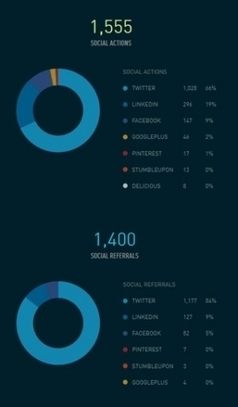 Your new post is loading...
 Your new post is loading...
...Are you planning projects that member outlets would be able to incorporate into their own websites? Absolutely! All of our interactives are embeddable, and our members and customers already incorporate them into their sites. I’m interested in ways we can customize our data-driven interactives, both for the customer and for the end user. Those efforts are part of our design discussion for the work we’re doing now. I would also like to find more ways to collaborate with other news organizations. AP was born from such cooperation, and it is an important part of our identity. Are the projects the AP works on more often than not driven from the print side, augmenting what’s being written by a reporter or team of reporters? Or do they sometimes originate from the digital side? If it is a case of digitally driving what reporters write, would you like to see a shift to data journalists promoting more original narrative work? More often than not, I’ve found that good data projects start with solid shoe-leather reporting, so most of our data projects have begun with the work of text reporters and editors. But the data work that we do begins before the story is written: exploratory data analysis can discover new angles in the data, and the right visualization can reveal a trend we had missed. We’re really moving away from the model in which visualization or interactive storytelling is an afterthought, an illustration of the story, and toward a model in which this work is central to developing the story and enables us to tell the story in ways impossible for straight text reporting....
The week of the Boston bombings has been a cascade of embarrassments for the news industry. On Wednesday, CNN falsely reported that arrests had been made. The New York Post, never known as a pillar of journalist ethics, sunk to a new low with a front-page photo on Thursday of two young men, captioned, “Feds seek these two pictured at Boston marathon.” The only hitch: These weren’t the suspects. One of them says he’s now afraid to leave his house. But should these media fails really surprise us? Those who have been paying attention know that media bosses have been in a race to the bottom for over a decade. As journalist Nate Thayer describes it, “Not only have all the editors and others responsible for ensuring balanced and accurate story, which was crucial to ensuring believable information, been eliminated in budget cutbacks, but the more overwhelming new reality is the age of instant in the new borderless digital information age.”
A round up of all the best insights from the live Q&A, which explored how alternative news sites platforms interact with mainstream news sites... The internet has enabled the proliferation of alternative news sites, such as blogs and community news platforms, providing consumers with a variety of perspectives. In our recent live Q&A, we explored what role these news platforms play in breaking news and how far they impact mainstream news reporting. Here is a selection of views from our recent live Q&A looking at the relationship between alternative news platforms and mainstream news sites.... Great insight... more local, more video, more activism, more news...
The grizzled vet and the digital native: Journalism has plenty of room for both to succeed. I spent eight years at AOL and I'll say this: I saw none of the great, all of the bad and some of the good. ... The blood sport during my AOL days was about the future of media companies — who would or wouldn’t survive the digital onslaught. Actually, it was much the same during my time at Newsweek in the 80s (who needed three newsweeklies in a broadcast world). Ditto when I joined The New York Times in the 70s (was the city big enough for both The Post and Daily News). Now, the social Web with its echo chamber turns up the volume daily — and makes it more personal, too. It’s far more about the fate of the individual journalist. That quickly gets down to the paycheck. Will there be one? How much? Who gets it — the “professional” or the pretender? Consumer demand for credible news and information is greater than ever. The problem is the 100-year-old model for producing it is forever broken. That’s why more attention must be paid to finding new ways to produce quality journalism — efficiently, at scale and at a price supported by mobile CPMs, which at best are 50% lower than desktop CPMs, which if you’re lucky come in two-thirds lower than print CPMs. In other words, a high-cost newsroom structure built for the print age will never work in a smartphone or tablet world. A few startups are experimenting with new models — Vox Media, Machinima, Bleacher Report and Storify are a few that I follow. Among traditional media companies, FORBES is the only one I know of charting a new course....
...The media loves to attach labels to trends. When one catches on, the rush begins. Native advertising (the buzzword of choice right now), social advertising, content marketing and sponsor curation all revolve around the notion of brands as publishers. Everyone’s jockeying for position, FORBES included. Marketers want a bigger voice. The media business needs revenue. The digital world demands change. So, what’s required for this new form of marketing — and for journalism to continue to flourish? Ah, here’s where the fun begins. Buzzfeed talks about viral content. The Huffington Post is into “aligning content and paid advertising strategies.”The Atlantic uses “Sponsor Content Presented By (pick the advertiser). Gawker’s done something similar (it’s actually now talking about a commerce play). As for us, I often talk about brand journalism. BrandVoice is based on the philosophical belief that marketers, with deep understanding of their industries, can offer smart insights, too. In most traditional media companies, that’s a tough sell. Journalists can barely swallow the advertorial — it must be placed in the print or digital equivalent of Siberia. The fact is is, with the click of a mouse or the touch of a screen, the audience can check a marketer’s veracity as easily as it can a journalist’s....
|
“Will anyone with information please come forward”. It’s a refrain we always hear police echo in crime-dramas. People are too afraid to come forward though for lack of trust in the official authorities or fear of gangs. That’s especially in poverty-stricken, gang-ridden areas. You can easily imagine the classic scene: New York cops at a ghetto crime scene with apartment residents hiding behind their curtains. Then again, we are constantly documenting massive amounts of potential evidence each time we post a photo via Instagram, a video via Vine or even a report by sending out an ‘eyewitness tweet.’ How do we filter the valuable truth from the inevitable noise of social media?
Social media and journalism are back in the ring this week. They’re both pretty strong contenders, but not without their weaknesses. In the immortal words of Paulie Pennino, let’s blow these punch-outs. In this corner: Journalism As the underdogs trying to maintain a presence and a living wage, we all know journalists have the power of story-telling and, hopefully, credibility, when news breaks. This Nieman Lab post illustrates the timeline of breaking the Boston bombing on Monday. It shows social media users were able to catch events up to the minute, but it’s only when Reuters retweets it that it becomes News. That’s all because of context. Journalism takes its hardest blows when it forgets that its mission is to provide context. To keep up with social media, journos have fallen prey to the allure of being first. Cable news outlets broadcast, and then tweeted, information about the ongoing investigation and hunt for the bomber without verifying information. Instead of relying on their credibility, their only other strength, media outlets engaged in a strange feedback loo....
A little more than a year ago, BuzzFeed made the leap into the realm of serious journalism. It hired some known journalists and a lot more hungry young writers, expanded its verticals, and announced a plan to create serious content to go alongside the site’s trademark clever lists. Now, with BuzzFeed creating a home for its long reads, building a business vertical and trying to figure out how to expand into breaking and international news, it’s a good time to assess....
Polis, the journalism think-tank at the LSE, has published an in-depth report looking at the value of social media to journalism, specifically public service broadcasting, and it highlights how Twitter has come to dominate news. As the report puts it, Twitter plays a more important role in newsgathering than Facebook, which is much more about discussion and far less about breaking news. Lyse Doucet, the BBC’s Chief International Correspondent puts it this way: “There is no question, if you are not on Facebook and Twitter, you are not getting the full story”. More telling is the comment from Joanna Carr, editor of BBC Radio 4′s news programme ‘PM’, who said she “wouldn’t hire anybody who doesn’t know how to use Twitter”....
Newsweek's top editors faced a different kind of danger than the Flying Wallendas. Katharine Graham, publisher of The Washington Post and owner of Newsweek, made a habit of decapitating her editors. ...Very few “star” journalists of that time and space have made the trip to the digital world. Most of those I spoke with and saw are pretty much doing what they did 20 and 30 years ago. They’re doing it for traditional media companies that haven’t changed much either, although executives at each have convinced themselves otherwise. Those no longer working romanticized about the past. The experience also reminded me of something I repeatedly told Tim Forbes three or four years ago when I was deep into my startup, True/Slant. “There’s a new wave of of talent out there that’s going to blow past traditional journalists — and they don’t even see it coming.”
We’re fortunate to have members of that new wave at FORBES. They do their jobs differently, particularly when freed from hierarchical editing systems to build their own brands and be accountable for their own success. They relate to and engage with the audience unlike a past generation of reporters who could care less what readers thought (after all, what do they know?). Using the tools of social media, they follow their colleagues as competitive beat reporters to gain insight from them. Most important, they banter with them in full public view, a far more raw, if not real, version of any “news analysis” than shows up in newsprint. Sometimes, they even ride the crest of a competitor’s scoop by filtering it through their own eyes for different audiences. They produce their own videos, photos and galleries and podcasts to extend their reach. And they trust in Google, angling stories (and a story’s headline) to give them the best chance of reaching the world. In the video below, six people who sit in our newsroom talk about their jobs and the FORBES model of digital journalism.
|



 Your new post is loading...
Your new post is loading...




















Watch for this trend - more multimedia and more interactive - in news according to the new AP interactive editor...